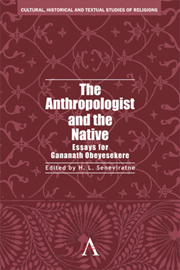Book contents
- Frontmatter
- Contents
- Editor's Note
- The Anthropologist and the Native: Essays for Gananath Obeyesekere
- SECTION I THE INDIAN TRADITION AND ITS REPRESENTATION
- SECTION II CASTE, KINSHIP, LAND AND COMMUNITY
- Recasting a Caste: The Case of the Dadhich Brahmans
- Reconstituting Village Communities: Sir William Gregory's Efforts to Renovate Village Agriculture in Ceylon's North Central Province
- Dowry in Batticaloa: The Historical Transformation of a Matrilineal Property System
- SECTION III RENUNCIATION AND POWER
- SECTION IV BUDDHISM TRANSFORMED
- SECTION V THE ENIGMA OF THE TEXT
- SECTION VI THE ANTHROPOLOGIST AND THE NATIVE
- List of Contributors
Recasting a Caste: The Case of the Dadhich Brahmans
from SECTION II - CASTE, KINSHIP, LAND AND COMMUNITY
Published online by Cambridge University Press: 05 May 2012
- Frontmatter
- Contents
- Editor's Note
- The Anthropologist and the Native: Essays for Gananath Obeyesekere
- SECTION I THE INDIAN TRADITION AND ITS REPRESENTATION
- SECTION II CASTE, KINSHIP, LAND AND COMMUNITY
- Recasting a Caste: The Case of the Dadhich Brahmans
- Reconstituting Village Communities: Sir William Gregory's Efforts to Renovate Village Agriculture in Ceylon's North Central Province
- Dowry in Batticaloa: The Historical Transformation of a Matrilineal Property System
- SECTION III RENUNCIATION AND POWER
- SECTION IV BUDDHISM TRANSFORMED
- SECTION V THE ENIGMA OF THE TEXT
- SECTION VI THE ANTHROPOLOGIST AND THE NATIVE
- List of Contributors
Summary
If caste in India has never been static, the pace of change accelerated from the mid-nineteenth century onward. This was a time during which elite members of many castes, in particular those most affected by urbanization and related social and economic changes, were beginning to develop new understandings of the nature of caste itself in parallel with new ways of managing their affairs as communities. This paper deals with an example of this process, particularly as it unfolded during the twentieth century. The extent to which it is typical is hard to say, but it seems likely to me that the scenario to be described here had many parallels elsewhere in the India of that period. The caste in question is a Brahman community of Rajasthan usually called Dahima or Dayma Brahmans. Many caste members, however, prefer to be called Dadhich Brahmans, and we shall respect this preference here. The caste was once concentrated in the hinterland of a temple located in Nagaur district between the villages of Goth and Manglod. This temple contains an aniconic image of a goddess named Dadhimati. She is, in fact, the focus of the caste identity of the Dadhich Brahmans and is at the center of our story.
The temple is of great interest on its own account. Although the present structure dates from the ninth century, an inscription found at the site and dated 289 G.E. (608 CE) shows that it existed in some form in the early seventh century (Meister 2000; 2003; Meister, Dhaky 1991).
- Type
- Chapter
- Information
- The Anthropologist and the NativeEssays for Gananath Obeyesekere, pp. 103 - 124Publisher: Anthem PressPrint publication year: 2011



